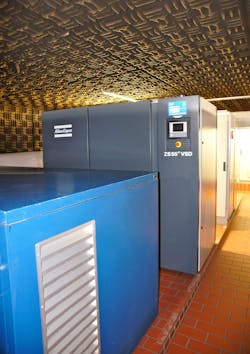Screw Blowers Contribute to Energy Efficiency at Sewage Treatment Plant
Two Atlas Copco ZS 55+ oil-free screw blowers with variable speed drive (VSD) supply energy-efficient compressed air to process sewage at the treatment plant in Versmold, Germany. As a result of the efficiency of the VSD, the plant has achieved energy savings of 10%.
The plant cleans around 3 million cu meters of sewage water every year. Sixty percent of this is industrial sewage water and the remainder is domestic sewage from the town of Versmold. Specific to the plant is the high proportion of industrial customers from the meat processing industry, which generates varying rates of high polluting loads and above-average quantities of phosphate that are a challenge for the plant to handle. The cleaning technology, measuring technology, process control system and compressed air technology must be able to quickly detect the pollution level of the sewage water and respond accordingly.
Nitrification and denitrification take place simultaneously in two aeration tanks. In the course of the aerobic degradation processes, the biological process is first supplied with oxygen via the plate aerators. During the subsequent anaerobic phase, only the tank contents are mixed together. Each of the tanks is supplied with oxygen via the three blowers.
An Atlas Copco ZS 55+ VSD oil-free screw blower takes over the control function in each case. The two machines, working together with two blowers supplied by another manufacturer, supply compressed air between 1,500 and 3,500 cu meters per hour with a target excess pressure of 500 mbar to maximum 600 mbar. The volume flow is automatically adjusted to the exact air demand by the variable speed drive.
"The blowers from Atlas Copco are compact and it is not necessary to make many modifications," said Khosrow Ghobadi, plant manager. "The machine is simply linked to the process control system, which we did easily without any problems."
Initially, however, only one of the two tanks was equipped with a ZS+ blower, "as we just wanted to check whether the promised increase in efficiency could be achieved," Ghobadi said. "At the end of the test run, we were actually able to determine that the blower from Atlas Copco was 10% more efficient than our other machines."
In light of this, the second screw blower from Atlas Copco was purchased. "The two machines have run smoothly for the past two years," Ghobadi said. "The only thing that we need to do is routine maintenance work."
Source: Atlas Copco
